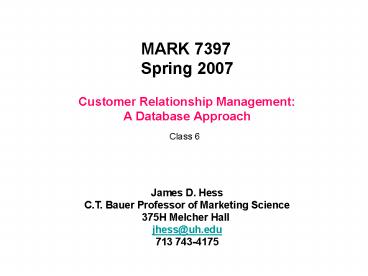Customer Relationship Management: A Database Approach - PowerPoint PPT Presentation
Title:
Customer Relationship Management: A Database Approach
Description:
Where i = number representing the customer, r = applicable discount rate ... abandonment, making this trickier than it looks. You need to understand NPV calculations. ... – PowerPoint PPT presentation
Number of Views:306
Avg rating:3.0/5.0
Title: Customer Relationship Management: A Database Approach
1
Customer Relationship ManagementA Database
Approach
MARK 7397 Spring 2007
Class 6
James D. Hess C.T. Bauer Professor of Marketing
Science 375H Melcher Hall jhess_at_uh.edu 713
743-4175
2
Past Customer Value
- Computation of Customer Profitability
- Past Customer Value of a customer
- Where i number representing the customer, r
applicable discount rate - n number of time periods prior to
current period when purchase was made - GCin Gross Contribution of transaction
of the ith customer in the nth time period - Since products/services are bought at different
points in time during the customers lifetime,
all transactions have to be adjusted for the time
value of money - Limitations Does not consider whether a customer
is going to be active in the future. Also does
not incorporate the expected cost of maintaining
the customer in the future
3
Spending Pattern of a Customer
The above customer is worth 302.01 in
contribution margin, expressed in net present
value in May dollars. By comparing this score
among a set of customers a prioritization is
arrived at for directing future marketing efforts
4
Lifetime Value metrics (Net Present Value
models)
- Multi-period evaluation of a customers value to
the firm
5
Calculation of Lifetime Value Simple Definition
CM2
CM1
Rrt
1/(1d)t
0
- where LTV lifetime value of an individual
customer in , CM contribution margin, ?
interest rate, Rr retention rate, so
Rrtsurvival rate for t periods - LTV is a measure of a single customers worth to
the firm - Used for pedagogical and conceptual purposes
6
LTV Definition Accounting for Acquisition Cost
and Retention Probabilities
Note many typos on page 127
Where, LTV lifetime value of an individual
customer in Rrk retention rate ? Product
of retention rates for each time period from 1 to
T, AC acquisition cost T total time horizon
under consideration Assuming that T ? ? and
that the contribution margin CM does not vary
over time,
7
To Calculate Customer Lifetime Value
- You must be able to forecast profit contributions
- You must understand the cost of marketing
- You must be able to forecast retention rates of
customers - (since if the customer has abandoned the firm
no profits - will flow.)
- It is possible that customers will churn. That
is, they may leave - and then return later.
- The contribution of a customer may be causally
tied to churn and - abandonment, making this trickier than it looks.
- You need to understand NPV calculations.
8
LTV Definition Accounting for Varying Levels of
Contribution Margin
- Where, LTV lifetime value of an individual
customer i in , S Sales to customer i, DC
direct cost of products purchased by customer
i, MC marketing cost of customer i
9
Recall the Cell2Cell data from last week
10
(No Transcript)
11
CMi(67.58.595Monthsi-7.615Marriedi-.046EqpDay
si)ContribRate
12
(No Transcript)
13
(No Transcript)
14
(No Transcript)
15
(No Transcript)
16
Abandonment versus Churn Lost for Good or
Missing in Action
States of Customer S0 bought this period
S-1 last bought one
period before
State Transition (Markov Matrix)
Before
Lost for Good
S0
S-1
S0
0.7
0.0
T
After
S-1
0.3
1.0
Pt(Pt,0,1-Pt,0) Probability that at time t
you are in the two states
17
Abandonment versus Churn (continued)
Before
S0
S-1
S0
0.7
0.0
After
S-1
0.3
1.0
Pt T Pt-1 T T Pt-2 T T T P0
0.7k
0.0
Tk
1-0.7k
1.0
This is the type of calculation we did above with
a retention rate of 70. However, once gone the
customer never returns.
18
Abandonment versus Churn just Missing in Action
Before
S-2
S0
S-1
S0
0.7
0.1
0.0
S-1
0.3
0.0
0.0
After
0.0
0.9
S-2
1.0
If you havent bought in two periods, you are
gone, but you could appear and disappear from one
period to the next.
19
Abandonment versus Churn just Missing in Action
20
(No Transcript)

